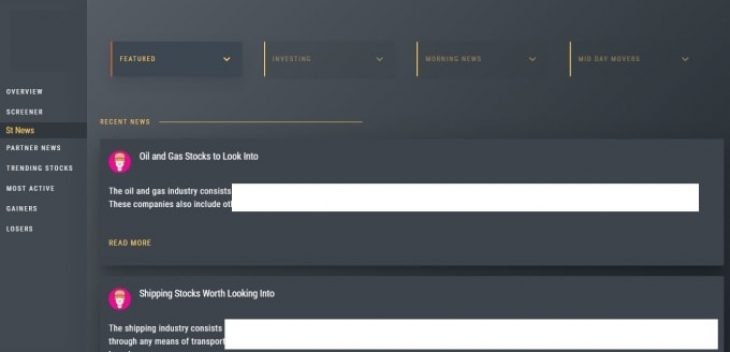
stock screener python
A Comprehensive Stock Screener in Python: Building a Powerful Tool

Source: medium.com
A stock screener in Python allows you to efficiently analyze a vast amount of market data to find potentially profitable investment opportunities. This powerful tool goes beyond basic research by enabling tailored filtering and analysis, helping you discover promising stocks that match your specific investment criteria. This in-depth guide explores the creation of a sophisticated stock screener using Python, focusing on essential concepts and practical implementations to maximize its utility for stock market analysis. The entire process centers around utilizing a stock screener python approach to enhance your investment strategy.
1. Introduction to Stock Screener Python
This article delves into constructing a stock screener using Python. A stock screener python project allows users to filter vast amounts of financial data to pinpoint promising investment candidates. Understanding the principles behind this stock screener python application can give significant insight into the practical application of Python for financial data analysis. Leveraging stock screener python is crucial to achieving efficient portfolio selection.
2. Project Setup: Libraries and Data Acquisition
Before delving into the stock screener python code, you'll need the right tools. Essential Python libraries for this project include Pandas (for data manipulation) and potentially libraries for web scraping and data API access like yfinance. Obtaining historical data for analysis, a cornerstone of the stock screener python application, typically comes from APIs or CSV files. How you obtain and organize data is key to developing a practical stock screener python application. This part fundamentally concerns how to set up your stock screener python project and lays the foundation.
2.1 How to choose libraries for your stock screener python
Choosing the right libraries is pivotal in developing a robust and efficient stock screener python tool. Libraries like Pandas, for DataFrame manipulation, are essential. Consider libraries specifically tailored to financial data analysis, like yfinance which fetches real-time market data crucial to your stock screener python. Understanding this step is essential for creating your tailored stock screener python.
2.2 Importing data from API's or CSV files (for stock screener python)
Fetching data using financial APIs is key to making your stock screener python operational. Learning to integrate and handle the structure of the received data for subsequent analysis is paramount. Consider using a library like yfinance. Accessing data using financial API keys (or free tiers where possible) is an indispensable element of creating a practical stock screener python.
3. Defining Investment Criteria: Key Parameters for Stock Screener Python
Crucially, investment criteria (e.g., price-to-earnings ratio, P/E, current earnings per share, EPS, and similar) is what filters results for a given stock screener python application. Setting these guidelines in advance provides the target for subsequent stock screener python functions. Understanding these stock screener python criteria is essential.
3.1 Setting Up Variables & Stock Screening Parameters in a stock screener python.
Establish variables and parameters that reflect the user’s criteria in a Python stock screener python application. Examples might include expected price targets, the desired stock’s P/E ratios, or earnings per share values relevant for the stock screener python project. You will manipulate these stock screener python parameters using your selected library's API.
4. Data Cleaning & Transformation (Stock Screener Python)
Cleaning up data and getting it into an ideal format is vital for the stock screener python process. In this stock screener python process, you will use Pandas, crucial to every effective stock screener python, to manage and organize your datasets. Missing values (which might need attention, due to data collection) and standardizing units and structures help you design a more functional and robust stock screener python. This critical step fortifies your stock screener python code's efficiency and reliability.
5. Filtering & Analysis (Using your Stock Screener Python Code)
Crucially, employing filters with your stock screener python implementation identifies potential stocks conforming to predetermined investment parameters in a stock screener python. The purpose of your stock screener python script hinges on selecting desired filtering strategies within the stock screener python. This part focuses on the implementation of the logic for stock screener python
5.1 Creating Screening Functions for Stock Screener Python.
Using code blocks that define criteria and select assets matching criteria will streamline the process in a functional and readable manner. Understanding how to build well-defined stock screener python functions for filtering stocks is key for effective analysis within a stock screener python.
6. Performance Metrics & Visualization for the Stock Screener Python

Source: workchest.com
Metrics will gauge and rate stock performance based on user specifications in a well-defined stock screener python function. Visualization tools are key to better understanding stock trends from the generated data using your stock screener python function, whether plotting trends, making statistical models, or performing other forms of data analysis using your stock screener python project.
7. Conclusion
The purpose of any stock screener python project, which hinges on data extraction, filtration, and visualization capabilities is to improve your analysis of potential investments using appropriate variables. By tailoring stock screener python criteria, this script efficiently identifies stock performance. Using Python to build stock screener python, understanding the process ensures your success in analyzing the market from the data within your own stock screener python. Your stock screener python should include a structured evaluation and a final judgment step.
8. Using Data Structures Effectively Within Your Python Stock Screener

Source: simply-python.com
Effective organization of the collected information via efficient stock screener python data structures is key in facilitating fast, intuitive filtering in this stock screener python. Understanding your stock screener python will also give you greater insights and enhance your use of relevant parameters for selection.

Source: backtrader.com
9. Managing Large Datasets within a Stock Screener Python Application
Efficient management and effective analysis of a wide spectrum of stock data, using well-structured functions in your stock screener python program, is key in getting accurate output to help make effective investment strategies in this stock screener python. Understanding data volumes that will feed your stock screener python is crucial in this step. This understanding leads to optimization of stock screener python tools.
10. How to Integrate Python and SQL with your Stock Screener
The utilization of a combination of stock screener python coding and SQL databases gives more advanced capabilities for manipulation, organization, and handling very large quantities of historical stock market data using efficient database interaction within your Python stock screener python. In this instance of integrating SQL and stock screener python data will further strengthen the functionality of your project and allow greater precision.
11. Testing and Refining your Stock Screener Python
Crucial aspects such as performance and correctness are ensured within an automated stock screener python.Testing this aspect ensures accuracy for filtering. By testing and refining your stock screener python code early and often, one minimizes errors that otherwise reduce the accuracy of the tool and increase the chance of missing pertinent stocks for screening in your stock screener python function. Refining ensures the stock screener python remains accurate and functions consistently.
12. Future Enhancements of your Stock Screener Python Application
Expanding and enhancing your stock screener python can incorporate external factors like news sentiment or technical indicators using data from external resources in conjunction with your internal data collected from APIs using this python stock screener python. Integration and appropriate organization of multiple data points from external sources with the existing information gives a robust, useful application and enhances your stock screener python capability. Real-time updates for your stock screener python could be crucial to further enrich functionality.
Remember to consider and prioritize security best practices in developing and using your stock screener python.


